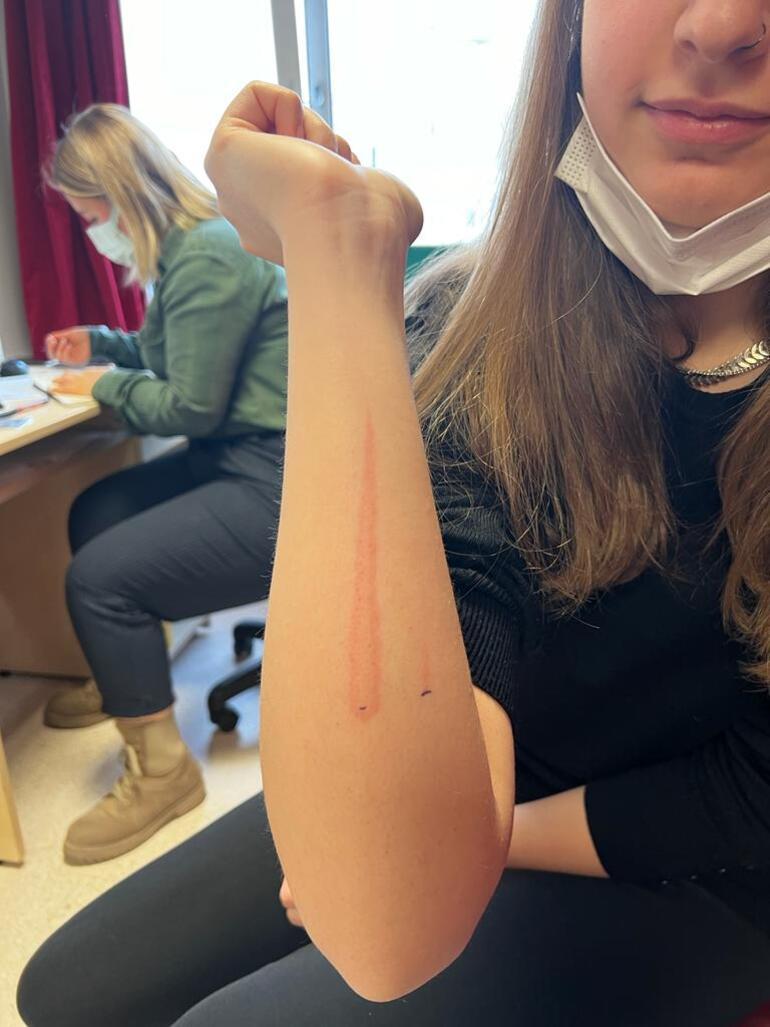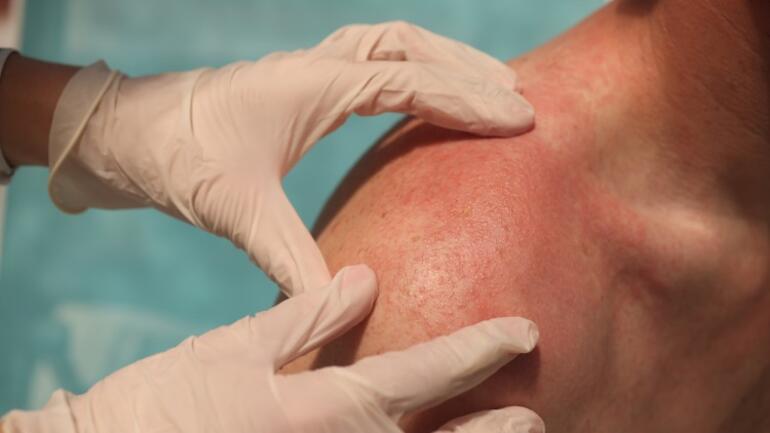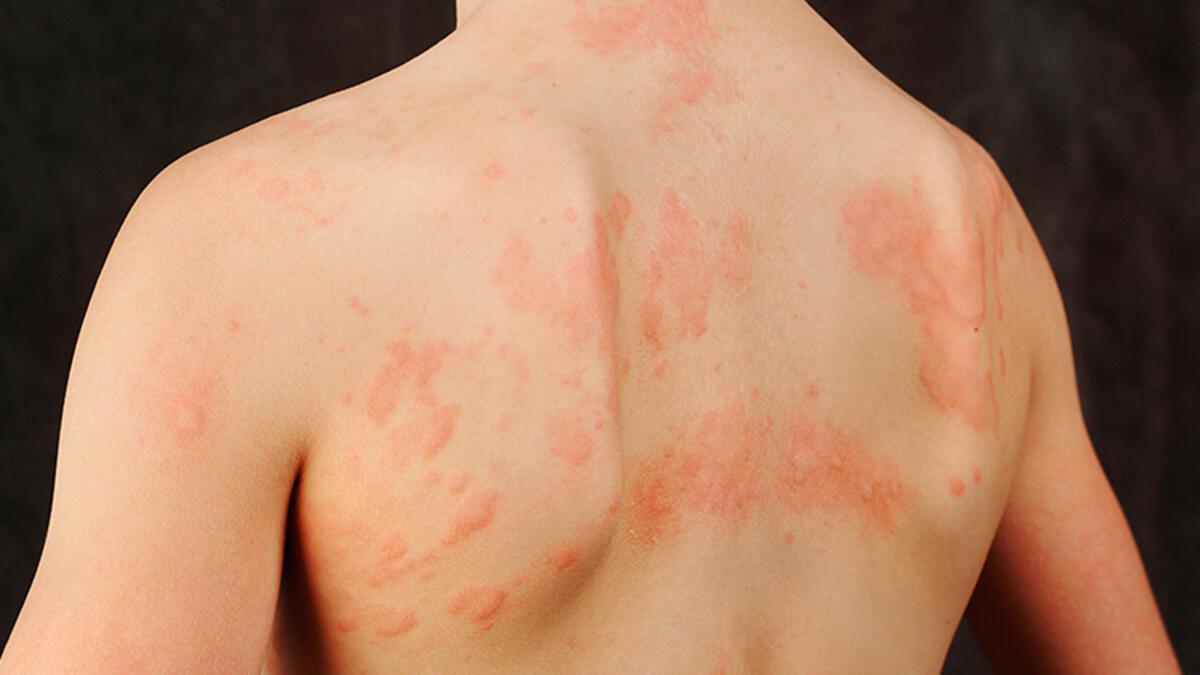class=”medyanet-inline-adv”>
While millions of children are looking for excuses not to walk to school, Calum Courtney has a very valid reason: cold allergy…
14-year-old Calum, who lives in England, is exposed to temperatures below 24 degrees for more than 15 minutes, his body begins to react. That’s why his family keeps the heating on all day and doesn’t take Calum out unless he has to, at the risk of an allergic reaction.
His parents claim that Calum’s condition is so severe that he immediately develops an allergic reaction on his arm or leg, which comes out of the duvet at night.
Since Calum couldn’t wear shorts and spend a lot of time outdoors, he even had to quit his favorite football game. “He used to get really upset because he really wanted to play football,” says his mother, Tupney.
class=”medyanet-inline-adv”>
Cold allergy, which usually causes itching, rash and hives, can sometimes be fatal. The potential threat Calum faces in his daily life is described by his mother as follows:
“You never know how your body will react to the cold. She could have a life-threatening allergic shock, even the slightest possibility, that could happen at any time.”
RAIN DAYS CAN HAVE BAD RESULTS
Calum’s school is about 45 minutes from their house. Since it is not possible for him to make this journey alone, he is taken to school by a family member every day.
“If it rains and gets wet on the way to school, it could have dire consequences,” her mother says. “Even if his clothes are slightly damp when taking him to the car on rainy days, it is necessary to change them all.”
Even Calum’s dressing in layers is sometimes not enough to curb the reaction caused by the cold. Whichever part of your body gets cold, it reacts first. In general, the face and hands are primarily affected by the cold.
FEELING LIKE IT’S BURNING
The allergic reaction starts out like chickenpox at first. The rashes grow and coalesce over time. “It feels like it’s burning and it’s really itchy,” Calum says.
class=”medyanet-inline-adv”>
Saying that they can’t use ice even for injuries, Tupney says, “I have to constantly warm him up, even support him from the inside with hot drinks.”
MIXED WITH POLEN ALLERGY
Calum’s first encounter with a cold allergy occurred at an outdoor wedding when he was four years old. His family thought the blisters on the boy’s body might be a reaction to pollen or a plant and gave him allergy medicine.
But the drugs did not work. The rashes were increasing, and his body was swelling. The real reason became clear only when winter came.
“As winter entered, the situation started to get dire,” Tupney says. “He used to play football at school on Fridays and his body was getting worse as the weather got colder.”
class=”medyanet-inline-adv”>
‘TRYING TO CONDUCE PEOPLE IS TIRING’
They looked for a solution so that Calum could do whatever he wanted. Doctors use a medicine to protect the child from the cold. life suggested a change in style, but changing their lives and moving abroad was not that simple for the Courtney family.
Little is known about cold allergy. “It’s a grueling battle trying to prove it to people,” Tupney continues. “They think you said my son doesn’t like the cold. It is very frustrating that no one believes him.”
“MOTHER I CAN’T BREATHE”
While cold allergies are rare, Calum isn’t the only one who suffers. 18-year-old AA, who lives in Ankara, has been struggling with cold allergies for years.
class=”medyanet-inline-adv”>
When AA, who had redness on her body due to cold at a young age, said, “Mom, I can’t breathe” one day, her family worried, and then they learned about their daughter’s allergies.
“When my daughter was 3-4 years old, when we went outside, we noticed that her skin was red and swollen. When we took him to the doctor, they said, ‘It could be a cold allergy’. However, we did not care about this situation because it was not constant,” said Anne EA, and she panicked when her daughter said “Mom, I can’t breathe” one day.
 —
—
When they went to the doctor, she learned that her daughter’s internal organs were swollen due to allergies, and therefore she could not breathe. Mother EA said, “My daughter said, ‘I’m blistering in the cold,’ and the doctor then did an ice test. A piece of ice was rubbed on his arm and I saw that part swell quite a bit in front of my eyes. The doctor said, ‘Your daughter has a very serious allergy to cold’ and warned us to be very careful. Because even a simple friend joke could cause my daughter’s death,” he said.
class=”medyanet-inline-adv”>
Mother EA said that her daughter had difficulty returning home when she had to go out in the cold, she began to itch and her cheeks turned ‘burnt’ red according to the degree of cold.
Studies reveal that one out of every 2,000 people in Europe suffers from a cold allergy.
–
This disease, which limits human life, is the Head of Hacettepe University Faculty of Medicine, Department of Pediatric Allergy and Asthma. prof. Dr. Bulent Enis Sekerel and Pediatric Immunology and Allergy Specialist Assoc. Dr. Hikmet Tekin Nacaroglu we talked to Experts answered all the curiosities…
THE MAIN RISK OCCURING IN THE WHOLE BODY
What are the symptoms of cold allergy?
Bulent Enis Sekerel: We often hear about allergies such as food, medicine, pollen, and house dust. There are also hot and cold allergies, but they are less well known in the community as they are relatively rare. In cold allergy, when the area of the body exposed to the cold starts to warm up again, symptoms such as redness, swelling, swelling, numbness, tingling and itching occur in that area within minutes. When it occurs in the whole body, a common allergic reaction, which we call anaphylaxis, known as ‘allergic shock’ in the society, may occur and be life-threatening.
When we are in cold environments, the places where the cold is felt the most on our skin are the areas of the skin that are in direct contact with the external environment, such as the hands, feet and face. Therefore, the symptoms of those with cold allergy are mostly seen in the hands, feet and face areas.
 —
—
What causes cold allergy? Is it congenital or can it occur later?
Bulent Enis Sekerel: We see cold allergy about 1 in 10 thousand people. Allergy is defined as an exaggerated reaction of the immune system to a non-harmful substance or factor, and in cold allergy, there is an exaggerated, faulty and inconvenient and even harmful reaction that occurs with exposure to cold. Our immune system is a learning structure and develops a response to every factor it encounters after birth. It can be seen clinically at any age and we cannot say that it is congenital.
REGULAR USE OF MEDICATIONS BRINGS RISKS
Can cold allergy be treated?
Hikmet Tekin Nacaroglu: The most important thing that individuals with cold allergies can do to prevent this allergy is to stay away from the cold. In cold weather, it is absolutely necessary to wear thick clothes and to ensure that as little as possible of the skin tissue comes into contact with the cold, protective gloves such as gloves and berets should be worn. In addition, the time of exposure to cold should be reduced. In addition, antihistamine drugs reduce the histamine secreted in cold allergy and histamine-related symptoms. Giving patients antihistamines before going out for a cold may help relieve symptoms..
Bulent Enis Sekerel: Although allergy medications, which we call antihistamines, have some benefit, they do not have the potential to prevent serious reactions, and if they are used regularly, they can have negative effects on attention, concentration and learning speed. The drugs, which are called smart drugs in the society, can effectively control this disease, but their use all over the world is currently very limited due to their high cost.
SEVERE CASES CAN CAUSE DEATH
Does cold allergy have fatal consequences?
Bulent Enis Sekerel: Sudden contact of large parts of the body with cold can cause common symptoms, and we call it cold anaphylaxis. Anaphylaxis can be life-threatening and even fatal. Early and appropriate intervention is life-saving.
Hikmet Tekin Nacaroglu: Cold allergy, although rare, can lead to allergic shock, which we call anaphylaxis, and can be life-threatening. In severe cases, we refer to it as anaphylactic shock; Serious clinical findings such as sudden fainting, shortness of breath, breathing difficulties, sudden drop in blood pressure, irregular heartbeat and increased pulse may occur. For example; Allergic shock may occur in situations that expose a large skin area to cold, such as taking a cold shower or swimming in a cold pool. Therefore, adrenaline-containing pre-filled syringe kits should be prescribed to patients with a history of allergic shock or severe reaction, and families should be educated about the use of these kits.
Is only the skin contact of the cold effective, or does eating or drinking something cold also trigger an allergy?
Hikmet Tekin Nacaroglu: Cold allergy usually causes swelling and redness on the hands after contact with cold water, and redness on the face in windy winter weather. However, it should not be forgotten that there may be swelling in the mouth, tongue, lips, even the throat and respiratory tract, which are in contact with cold, such as drinking cold drinks or ice water, eating ice cream.
 —
—
EVERY PATIENT WITH URTIMER CAN EXPERIENCE A COLD ALLERGY
What other diseases does it bring?
Bulent Enis Sekerel: It is known that cold allergy may accompany other urticarias that occur spontaneously or occur with physical stimuli. For that reason Every patient with urticaria should be evaluated for other concomitant urticaria types and cold allergy. Although initial studies have shown that people with allergies have more cold allergies, some studies in recent years suggest that this may not be the case. Therefore, we think that the risk of cold allergy is not low for those who are not allergic anymore.
Hikmet Tekin Nacaroglu: Cold allergies can cause allergic symptoms to be observed both in our upper airways and in our lower airways, apart from skin symptoms. It should be kept in mind that allergic rhinitis complaints such as sneezing, nasal congestion, nasal itching, watery eyes, itching can cause asthma-like complaints such as coughing, wheezing and shortness of breath as a result of narrowing in the lower airways.
How is cold allergy diagnosed?
Hikmet Tekin Nacaroglu: The ice cube test is known as the most commonly used test to diagnose cold urticaria. During this test, an ice cube or 0-4 degree cold object is brought into contact with the skin on the forearm for 4-5 minutes. The skin is then expected to warm up for about 10 minutes. The diagnosis is confirmed by the reddening and swelling of the area of skin in contact with ice after heating.
–


